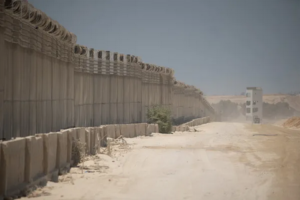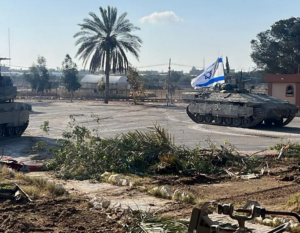Explained: Philadelphi and Netzarim, the two ‘corridors’ blocking a Gaza-Israel cease-fire

The Philadelphi corridor at Rafa in Gaza, July 2024
Allison Kaplan Sommer writes in Haaretz on 21 August 2024:
A deal between Israel and Hamas that could see hostages released and a cease-fire sealed – and possibly a regional war averted – has been paralyzed for months. Two small strips of land – the Philadelphi corridor along the Gaza-Egypt border and the Netzarim corridor that bisects the Gaza Strip – are now seen as the main obstacles to an agreement.
This week, with negotiations at a critical phase, Prime Minister Benjamin Netanyahu maintained his hard line, declaring, “Israel will not under any circumstances leave the Philadelphi corridor or the Netzarim corridor, despite the enormous pressure both at home and abroad.”
So where are these corridors and why are they so important to Israel?
What is the Philadelphi corridor?
This route is essentially another name for the Gaza-Egypt border. The corridor – sometimes called the Philadelphi route – is about 100 meters wide, spanning the 14-kilometer (8.6-mile) length of the Gaza side of the border and including the Rafah crossing with Egypt.
The choice of the name “Philadelphi” is random: It was the Israel Defense Forces’ code name for the demilitarized zone between Egypt and Gaza set up under the 1979 peace treaty, the product of the Camp David Accords. Egypt refers to the zone as the Salah Al-Din corridor, named after Saladin, the Sultan of Egypt and Syria who defeated the Crusaders in Jerusalem in 1187.
In 2005, as part of Israel’s withdrawal from Gaza, Israel and Egypt signed an agreement for the deployment of 750 Egyptian police officers to staff the route after Israel completed its pullout from the Strip. This agreement, including the official designation of the corridor, aimed to prevent the entrance of terrorists, arms and other contraband into Gaza via the smuggling tunnels that already existed.
After Hamas seized control of Gaza in 2007 from the Palestinian Authority, Israel imposed a blockade on the Strip, and Egypt increased restrictions on movement to and from Gaza. As a result, the network of smuggling tunnels dramatically expanded over the years in both number and size, becoming large enough for vehicles to pass through.
At various points, the tunnels have been ignored or targeted and destroyed by the Egyptians, depending on the government and interests in Cairo at the time. But the tunnels have never ceased to be a serious security threat to Israel.
What has happened during the Gaza war that began on October 7?
On May 29, as part of its controversial move into the Rafah region, the Israeli military announced that it had taken full control over the Philadelphi corridor, with the goal of thwarting Hamas’ ability to rearm and resupply. Israeli officials said that Israeli troops had discovered more than 20 tunnels during the operation, as well as 82 access points to those tunnels.

Israeli tanks at the Rafah crossing on the Philadelphi corridor in May 2024
Hamas isn’t alone in declaring fierce opposition to Israel’s takeover of the Gaza side of the Rafah crossing – Egypt is against it too. In response, Egypt closed its side, halting movement of vehicles and people until the other side is controlled by Palestinians, not Israelis.
Why is the corridor a sticking point in the negotiations?
Ever since Hamas’ October 7 attack on Israeli communities near Gaza, the Netanyahu government has said Israel must maintain control over the corridor, including the Rafah crossing, as the only way to prevent Hamas from rearming. But Hamas demands a full Israeli withdrawal from the area as a condition for a hostage deal.
As a result, the Americans, Egyptians, Qataris and Israelis have been brainstorming in a bid to bridge the gap between continuing Israeli control and handing the corridor back to Hamas. Negotiations in Qatar and Egypt have focused on the size and scope of a continued Israeli presence in an attempt to come up with a solution acceptable to all sides – Israel, Hamas and Egypt.
What about the Netzarim corridor?
The Netzarim corridor is a road that bisects the Gaza Strip, and stretches from the Israeli border to the Mediterranean Sea. The corridor was first mentioned in an Israeli plan from the early 1970s named “The five fingers plan” that aimed to dissect the Strip in order to allow Israeli military control of Gaza.
The actual corridor, running through the southern part of Gaza City, is around 7 kilometers (4 miles) long and only came into being during the current war. An Israeli minister told CNN earlier this year that the Netzarim corridor would make it possible to travel from Kibbutz Be’eri – one of the Israeli communities attacked on October 7 – to the beach, in only seven minutes.
Netzarim is the name of the Israeli settlement that stood where the corridor is now, giving the project of the new road a whiff of a reoccupation. Palestinians are banned from this route, which contains Israeli bases for the forces that control the movement of Palestinians between the north and south. These bases also serve as a launchpad for Israeli operations.
At the beginning of the war, the IDF ordered residents of northern Gaza to evacuate to the south using key roads that cross the Netzarim corridor.
The corridor is believed to be a major element in a long-term plan by Israel to cut Gaza in two and monitor a future buffer zone between Gaza and Israel, designed to prevent October 7-style attacks.
IDF sources have told Haaretz that the Netzarim corridor will allow Israel to monitor and control the movement of Palestinians between the north and south. The Israeli government says that such control is necessary to ensure that weapons and terrorists don’t reenter northern Gaza once civilians are allowed to return.
Hamas has insisted that a condition for any agreement is an Israeli withdrawal from both the Philadelphi and Netzarim crossings.
This article is reproduced in its entirety
